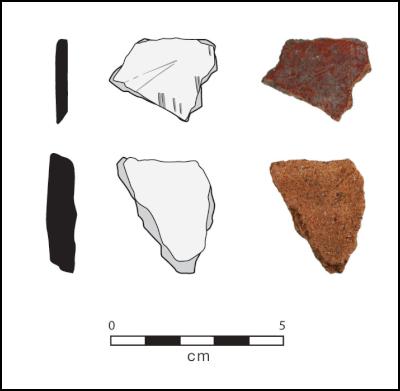Re-dated New Guinea pottery: early Austronesian fingerprint

Thursday 3 September 2015
Re-dated New Guinea pottery reveals early Austronesian “fingerprint”
A University of Otago-led research team has unexpectedly discovered the first evidence that the ancestors of Polynesians did not bypass New Guinea on their way from Southeast Asia to colonise remote areas of the Pacific, as was previously thought.
Radiocarbon re-dating of an archaeological site in the rugged New Guinea interior and petrographic and geochemical analysis of pottery fragments found there show that influences of these Austronesian-speaking peoples had penetrated into the already populated remote interior of New Guinea by 3000 years ago.
The more than 3000-year-old fragments, which resemble the Lapita plain-ware pottery style associated with Austronesian colonisation of neighbouring Western Pacific islands during the same period, were analysed and found to be both produced on-site and brought in from elsewhere.
The pottery was excavated at the remote highland Wañelek site around 40 years ago. Up until this latest study, no pottery in the Highlands region has had confirmed dating beyond 1000 years ago.
The surprising finding is newly published in the leading international journal PLOS ONE.
Lead author and Otago Archaeology Master’s student Dylan Gaffney says the study overturns the existing consensus that Austronesian peoples, who are associated with the Lapita culture, simply skirted the coastal areas of New Guinea and did not interact with inland populations.
“It was thought that they bypassed this large landmass, opting instead to settle on islands in the Bismarck Archipelago before continuing an epic migration that ended with the colonisation of remote Pacific Islands such as those of Vanuatu, New Caledonia, Fiji and Samoa,” Mr Gaffney says.
He says the team’s identification of a clear Austronesian “fingerprint” by 3000 years ago in the New Guinea Highlands rewrites the history of people’s presence in this important region.
“Crucially, the pottery comes from the interior rather than a coastal area, suggesting the movements of people and technological practices, as well as objects at this time.”
Research team members Professor Glenn Summerhayes of Otago’s Department of Anthropology and Archaeology and Dr Judith Field of the University of New South Wales have been awarded AUD$500,000 as part of an Australian Research Council Grant to continue archaeological research in the Wañelek area. Archaeology students from Otago and Papua New Guinea will be taking part in this work.
Publication Details:
Earliest Pottery on New Guinea Mainland Reveals Austronesian Influences in Highland Environments 3000 Years Ago
Dylan Gaffney, Glenn R. Summerhayes, Anne Ford, James M. Scott, Tim Denham,
Judith Field, William R. Dickinson
PLOS One DOI: 10.1371/journal.pone.0134497
http://journals.plos.org/plosone/article?id=10.1371/journal.pone.0134497


 Business Canterbury: Urges Council To Cut Costs, Not Ambition For City
Business Canterbury: Urges Council To Cut Costs, Not Ambition For City Wellington Airport: On Track For Net Zero Emissions By 2028
Wellington Airport: On Track For Net Zero Emissions By 2028 Landcare Research: ANZAC Gall Fly Release Promises Natural Solution To Weed Threat
Landcare Research: ANZAC Gall Fly Release Promises Natural Solution To Weed Threat NZ Anti-Vivisection Society: Auckland Rat Lovers Unite!
NZ Anti-Vivisection Society: Auckland Rat Lovers Unite! University of Canterbury: $1.35 Million Grant To Study Lion-like Jumping Spiders
University of Canterbury: $1.35 Million Grant To Study Lion-like Jumping Spiders Federated Farmers: Government Ends War On Farming
Federated Farmers: Government Ends War On Farming



